Peugeot 308 Review 2025: Price, specs & boot space
Written by Lawrence Allan
Quick overview
Pros
- Attractive and quirky inside and out
- Tech is much better than previous 308
- Good overall driving experience
Cons
- Disappointing rear seat space
- Lack of manual gearbox option
- Driving position won't suit everyone
Verdict: Is the Peugeot 308 is a good car?
"The Peugeot 308 proves that settling for a mainstream family hatch doesn't have to mean compromising on style and feel-good factor. Some compromises remain, but with a well-sorted driving experience, punchy engines, a quality feel and greatly improved tech, it's a strong choice."
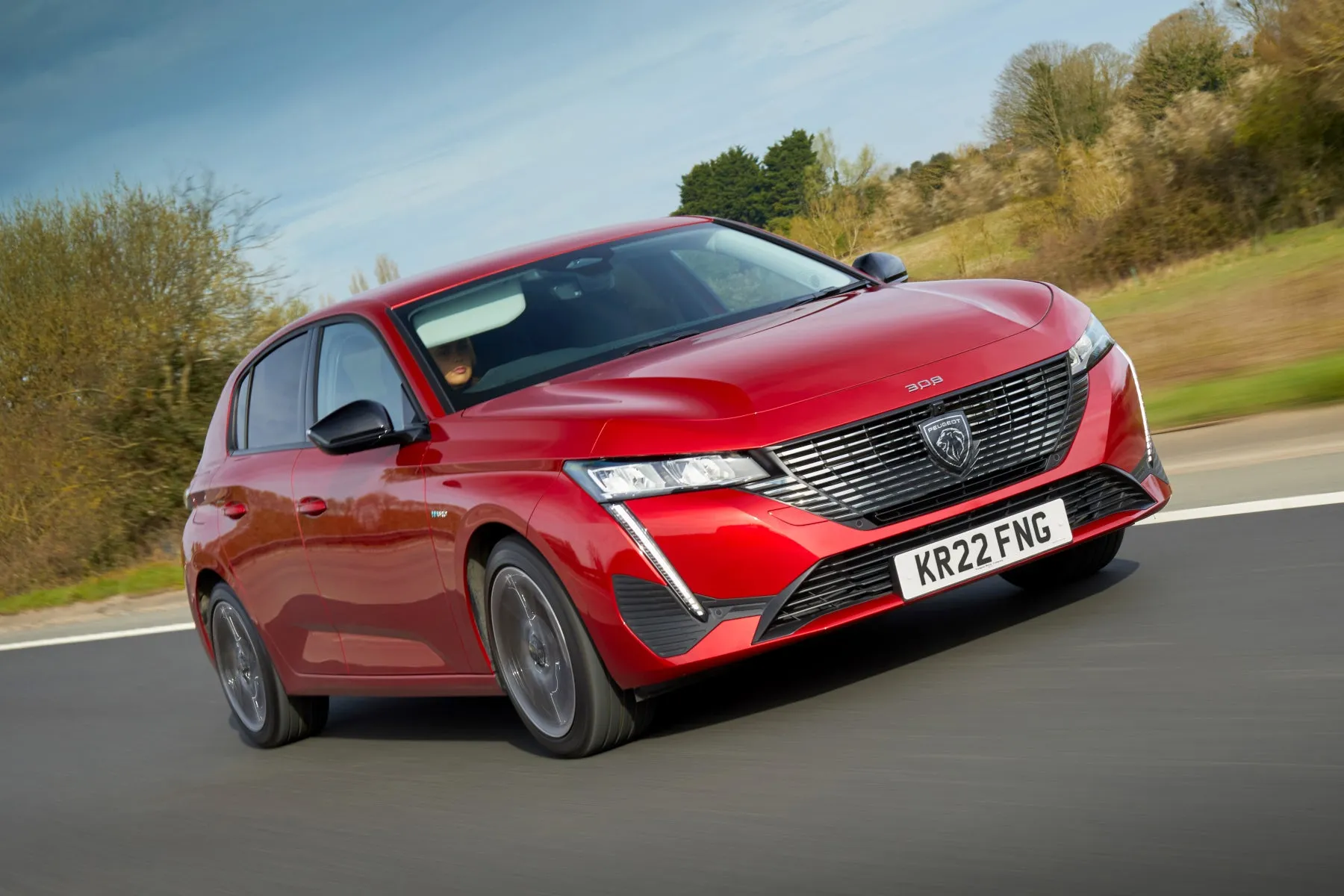
It appears Peugeot has decided that eight is great, as all of its core models (from the 208 small car to the 5008 seven-seat SUV) have stuck with the same numerical model designation for about a decade now. That means this, the latest Peugeot 308, is the third model from the French brand of the same name. In this review, though, we'll show why eight really is great.
Despite the huge popularity of family SUVs these days, hatchbacks such as the 308 are still big business. Standing out from the crowd isn't easy when you're battling fine competitors such as the Volkswagen Golf and SEAT Leon, the Ford Focus, the Toyota Corolla and the Mazda 3, to name just a few.
The Peugeot's design certainly does just that. It's closely related to the latest Vauxhall Astra, a car that has transformed from worthy but dull to surprisingly stylish. But the 308 goes a step further still with its dramatic front-end, fang-like LED lights, creased bodywork and shapely rear-end. It's more overtly showy than subtly classy, but that's better than being anonymous.
The interior, too, is an interesting place to sit with its angular shapes and varied surfaces. There's more going on than there is in the Astra, while Peugeot's i-Cockpit cabin design gives it a unique selling point, although it still won't suit drivers of all shapes and sizes. Quality is largely very good, too, with some pretty classy materials.
The old Peugeot 308 also had a surprisingly upmarket feel, too, but lagged behind the best when it came to technology and usability. Peugeot has done a good job of rectifying that with its new, much improved infotainment, with dual screens and novel customisation to allow easy access to commonly-used features. Indeed, the main downside of the cabin is now the mediocre rear seat space, which is barely better than the old 308 and a fair way behind the class best.
On the road, the Peugeot 308 offers an agile and composed driving experience, managing to be fairly enjoyable to steer around a twisty road while still offering good ride comfort. Granted, a Ford Focus is that bit sharper and more engaging, while a VW Golf is more adept at isolating you from bumpy surfaces, but it strikes a decent balance. The engine line-up has changed quite a bit during the car's time on sale, but there isn't really a bad choice to be made.
In terms of pricing, there are better value family hatchback offerings on the market than the latest Peugeot 308. That's where the cheaper Vauxhall Astra comes in, for example. But the Peugeot is more affordable than premium offerings such as the BMW 1 Series and Mercedes A-Class, while strong residuals for the 308 mean competitive leasing costs and - for those that buy outright - a car that holds its value.
Put that all together and there's much to like about the new Peugeot 308. There may well be rivals that tick more objective boxes, with practicality a bit of a weak spot. However, as a style-focused, good-to-drive hatch with premium appeal, it's a worthy member of the class.
Looking for a used car for sale? We've got 100s of Peugeot Approved Used Cars for Sale for you to choose from, including a wide range of Peugeot 308s for sale. If you're looking for the previous version, you need our used Peugeot 308 (2014-2021) review
Is the Peugeot 308 right for you?
The Peugeot 308 is a good car to choose if you want a family hatchback that doesn't look or feel ordinary. It'll stand out in the office car park next to some of the more unexciting offerings, that's for sure.
It'll also be great for long journeys thanks to good comfort and refinement, yet its relatively compact size means it's easy to park and manoeuvre around town. However, it might not suit family buyers due to its mediocre rear seat space: something like a SEAT Leon or Skoda Octavia is much better in that respect.
What other cars are similar to the Peugeot 308?
The Volkswagen Golf and SEAT Leon are both solid competitors for the Peugeot 308, as are the Toyota Corolla, Ford Focus and Honda Civic. There's also the Vauxhall Astra, which shares much with the 308, but at a more affordable price.
The 308 is arguably more desirable than some of those, so if style matters, the Mazda 3 is a great buy. There's also the Renault Megane with similar French flair, while at the other end of the scale, the Kia Ceed and Hyundai i30 are solid if unexciting choices.
We'd also look towards other Peugeot siblings from Citroen and DS. The Citroen C4 is likeable, comfortable and affordable, while the DS 4 has a classy look and upmarket cabin with loads of kit.
Comfort and design: Peugeot 308 interior
"The Peugeot 308's interior takes everything that was good about the old one's - namely the quality feel and design - and adds in much improved technology. Space for rear passengers is disappointing, though."
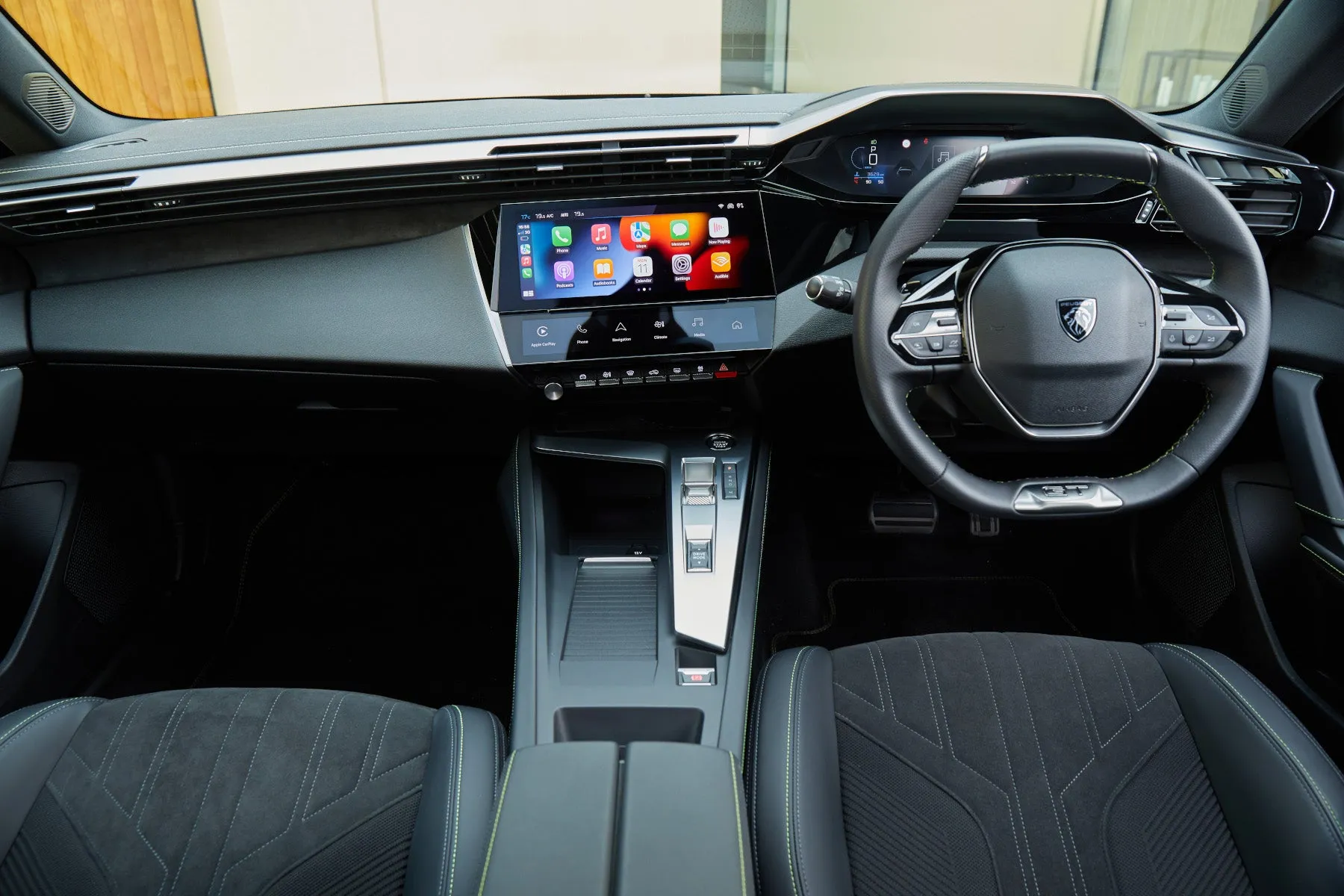
Step inside the Peugeot 308 and it's clear to see that a lot of attention has gone into the cabin's overall look and feel. It's a cut above cars such as the SEAT Leon and Toyota Corolla, that's for sure.
There's a striking, angular dashboard design with a nice mixture of materials, almost all of which are soft-touch. Peugeot hasn't covered the entire centre console in gloss black trim, either, meaning only the touchscreen will be a fingerprint magnet. Only the GT model gets multi-colour ambient lighting, but overall it's even nicer in perceived quality than the old 308.
Peugeot is sticking firm with its 'i-Cockpit' dashboard and driving position combination, which give you a small steering wheel and high-mounted digital dial display that you view by looking over the wheel, rather than through it as in most cars. Most drivers of average size will get on with it, but taller drivers might find that they have to compromise between being able to see the bottom section of the dials without leaning over, and having the wheel a bit too low between your knees. It's worth trying it before you buy.
We like the feel of the wheel itself, however, and we welcome Peugeot's decision to stick with physical wheel buttons in the new 308 rather than fiddly touch controls. Speaking of which, there's now some physical toggle 'piano keys' for various features below the touchscreen, which makes things a little easier to use on the move.
The main 10.0-inch touchscreen is larger than before on all models, with a much crisper display, better responses and reasonably intuitive menus. A novel touch, though, is a second touchscreen panel below the main display that features customisable shortcut widgets. You can set these to operate the things you use most, such as selecting your favourite radio station or calling a commonly used number. It's a handy way to make things easier to operate while you're driving.
Storage is pretty good, too, helped by there being no manual gearbox available on any Peugeot 308s, and there being a compact shift-by-wire toggle switch for the automatic gearbox. The biggest downside? That's to be found when you step into the back, as we'll talk about in the space and practicality section...
Quality and finish
Peugeot has really upped its game in interior quality in recent years, and that began with the last-generation 308.
Indeed, it's right up there with the latest VW Golf for fit and finish, and the materials used actually feel better in some areas. We really like the solid-feeling door grab handles, abundance of soft plastics, suede-like trim or leather on the dashboard and doors, and the overall feeling that you're in something a bit higher-end than your typical family hatch.
Granted, poke around lower reaches of the cabin (such as the door pockets and glovebox lid) and you will find harder, less tactile plastics. But accepting what the Peugeot 308 costs, this really isn't a big deal.
Infotainment: Touchscreen, USB, nav and stereo in the Peugeot 308
Every version of the Peugeot 308 gets a 10.0-inch central touchscreen. Its paired with a 10.0-inch digital dial display (again standard on all models), with basic voice control on all versions. Apple CarPlay and Android Auto also come as standard.
Higher end models get the second screen for the i-Toggles (yes, it's really called that... ) below the main touchscreen for the shortcut widgets, along with sat-nav, which also brings live traffic updates and speed camera alerts. They also get a more advanced voice control system (activated by saying 'OK Peugeot).
In early 308s, it was only the entry-level Active trim that got the basic system, while Allure and GT got the more advanced one. When the range was pared back to just Allure and GT in XXXX, though, Allure got the basic system and only GT got the more advanced one, so if this is a deal-breaker for you, be careful if buying an Allure on the used market.
Aside from that, the only further upgrade available is to the stereo. All models get a six-speaker sound system, but a premium Focal system with extra speakers and better sound is available as an option on the GT trim.
Space and practicality: Peugeot 308 boot space
Get your tape measure out and you'll see that the Peugeot 308 is about par for the course in terms of exterior dimensions, at 4367mm long, 1852mm wide and 1441mm tall. That's over 100mm longer than the old 308, and nearly 50mm wider.
Up front, there's plenty of headroom and lots of cabin width, meaning no banging elbows as you fight over the centre armrest. The i-Cockpit driving position isn't suitable for everyone, though: the very tall will find they have to fix the steering wheel unnaturally close to their legs to be able to fully see the dial display behind. We wish Peugeot wouldn't mount the pedals so close to the driver, as it would allow long legs to stretch out better.
There's a lot more to complain about for tall adults in the back, though. If a six-footer is sat behind a similarly-sized driver they'll have their knees dug firmly into the seatback, and if they're even taller than that, they'll have to splay their legs either side of the seat. What's more, the bulky front seats don't allow you to really slide your feet underneath, while headroom isn't particularly brilliant, either. Most hatchback rivals are roomier.
That's a pity, because the same issues afflicted the old 308, and it doesn't feel like a huge improvement has been made. The rear seats themselves are comfortable, though, so smaller adults and children will be fine, while there isn't a big lump in the floor so the middle seat is fairly usable. Of course there are ISOFIX points back there for mounting child seats, too.
Thankfully, the Peugeot 308's boot is a much more competitive size. At 412 litres it's actually smaller than the old model's, but that's still a greater figure than in the VW Golf and Ford Focus. It's worth noting, though, that in the plug-in hybrid and EV models, the boot space drops to 361 litres because the battery pack is under the boot floor.
Storage within the cabin is decent, with deep door bins in the front, smaller ones in the back and a cubby below the centre armrest. The 308 is also the first Peugeot in decades that doesn't have the fuse box taking up space in the glovebox in right-hand drive cars, meaning there's a much more useable space.
Handling and ride quality: What is the Peugeot 308 like to drive?
"The Peugeot 308 offers a decent blend of comfort and handling to make it pretty enjoyable to drive. It's not quite as plush-riding as a Golf, nor as sharp as a Focus: it's somewhere in the middle."
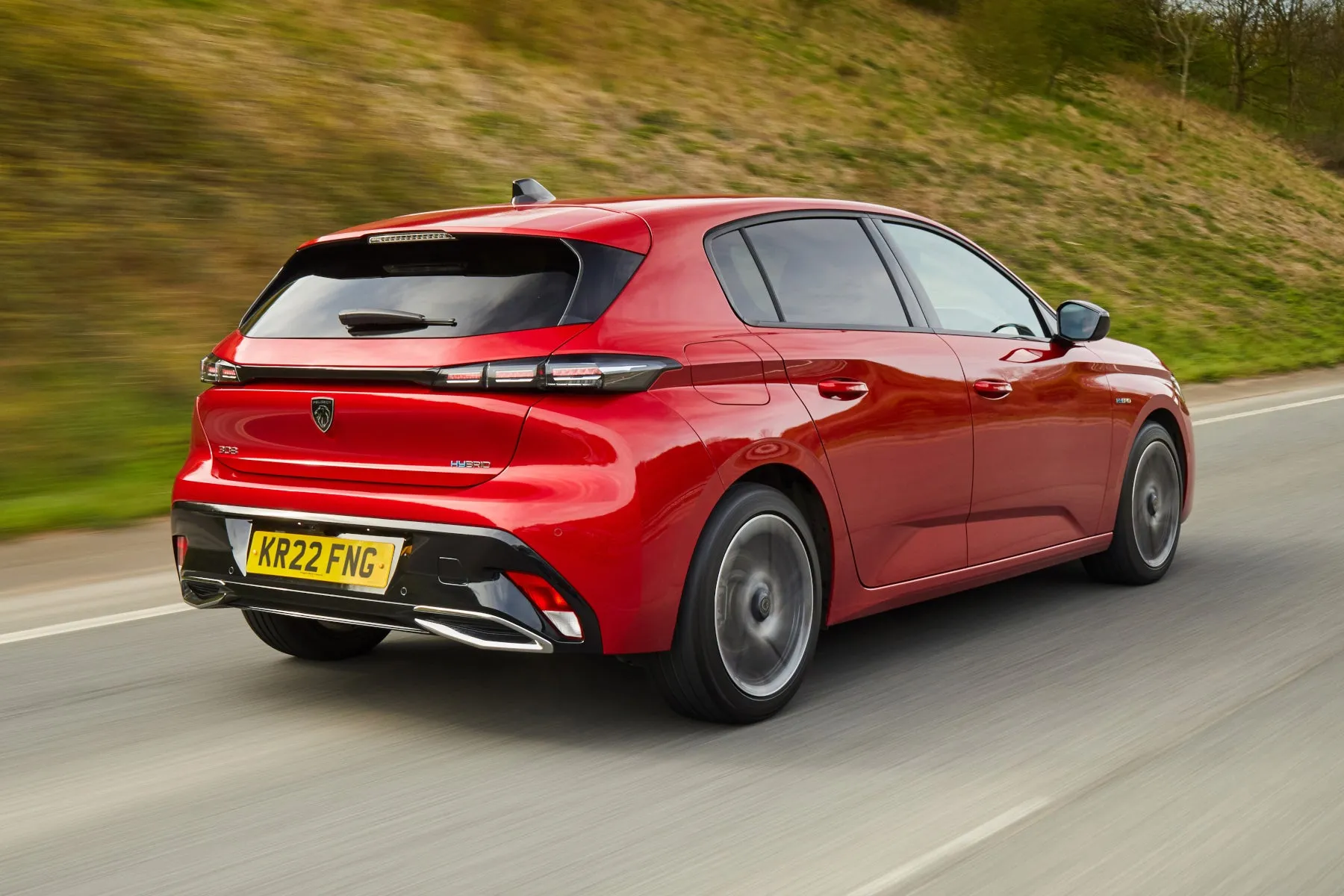
The Peugeot 308 is pretty capable on the road overall. While it perhaps doesn't shine in any single area, it offers a generally polished driving experience that makes it competitive in the class.
The small steering wheel helps heighten the 308's sense of agility, meaning it feels more eager to turn into bends than some rivals. That, combined with a decent turning circle makes it quite nippy around town. Forward visibility is good, but the rear window is small and the pillars are thick. In early cars, the base Active model got rear parking sensors, while mid-spec Allure model got a reversing camera, too, while GT got a full 360-degree camera with self-parking assistance. When the range was pared back to just Allure and GT, both got rear sensors and the reversing camera, while the 360-degree arrangement became an optional extra.
On the open road there's a reasonable amount of enjoyment to be had, though how agile it actually feels depends on the version. Plump for the pure petrol or diesel model and it turns in nicely, stays pretty well controlled and feels light on its feet. The extra 300kg+ added to the plug-in hybrid and EV models does impact this, but it's not as wallowy as you might think. There's plenty of grip on every model, too.
The 308 excels on the motorway, with ride comfort that gets better the faster you go (it's slightly thumpy on rough roads with the biggest wheels fitted, but pretty good overall and definitely more forgiving than a SEAT Leon) and good overall isolation from wind- and road noise.
Overall, the Peugeot 308 doesn't break any ground when it comes to the driving experience, but it delivers a good ride and handling balance, so it doesn't do anything that'll put buyers off.
What engines and gearboxes are available in the Peugeot 308?
The range of engines offered in the Peugeot 308 has changed a fair bit over time, so you might have to bear with us a bit while we explain. In early cars, you had the choice of one petrol engine, one diesel engine, a pair of plug-in hybrids, and an EV for the full house. We'll only talk about 308s with a combustion engine here. If you're interested in the electric version, we've written a separate Peugeot e-308 review that covers all this off.
In those early days, the cheapest available 308 was powered by the 1.2-litre Puretech 130 petrol engine, which makes 130PS and 230Nm. It was actually our favourite version to drive out of the range. 0-62mph comes around in 9.7 seconds, but it feels a bit faster than that thanks to a punchy mid-range, while the rorty engine note encourages you to get a move-on. The Puretech 130 is easily the lightest 308, too, which helps handling.
The 1.5-litre BlueHDI diesel engine has the same power as the petrol, but more torque (up to 300Nm), yet is actually slower from 0-62mph because of the gearing: it takes 10.6 seconds. We've no complaints regarding the performance, though, and it's actually pretty refined overall for a diesel.
Then come the two plug-in models - the Hybrid 180 and Hybrid 225 - both of which remain front-wheel drive and combine a 1.6-litre four-cylinder turbo petrol engine with a 110PS electric motor. All that changes between the two is the petrol engine gets a higher state of tune in the 225PS variant.
We've driven the 225PS model, which is pretty good but not perfect. For starters it's usefully punchy in electric-only mode, meaning you can pull smartly out of a junction and easily get up to motorway speeds without waking the petrol engine. Combine the two power sources and it's fairly brisk, too, while it's refined when you're cruising around.
However, it suffers from the same problem that afflicts many PHEVs, namely that when you stab the throttle to overtake or quickly get up to speed, you have to wait for what feels like an age before the gearbox, engine, and electric motor have decided between themselves what's needed, and deliver full power.
Similarly, another common problem is that by having to blend regenerative braking and normal friction braking through the same pedal, the brakes can be grabby, making it tricky to come to a stop smoothly. It's not a deal-breaker, but it takes some getting used to.
All early 308s use the same eight-speed automatic gearbox with paddleshifts to manually select gears. The changes are smooth, and while it's a bit slow to react in the hybrid, it delivers fairly swift kickdown in the petrol and diesel models. The manual response is nowhere near as fast as a dual-clutch gearbox, however.
More recently, the engine offering has changed. The entry-level choice became a 136PS mild hybrid version of the 1.2-litre petrol engine, operating through a six-speed dual-clutch automatic gearbox, but it wasn't long before this was itself switched out for a 145PS iteration. Unfortunately, we haven't had the chance to try either. Unlike with many competitors, the diesel version continues unchanged.
The lower-powered PHEV version also continues unchanged, but the more powerful PHEV option has been switched out for a 195PS version that operates through a seven-speed automatic transmission. We haven't had the chance to try it yet, though. Interestingly, the power mix is opposite to before: both PHEVs receive the same amount of power from their petrol engines, and it's the amount of power provided by the petrol motor that differs.
Refinement and noise levels
The 308 is good at isolating you from wind- and road noise, and while really rough roads do bring some thumping from the suspension, it's pretty quiet overall.
The three-cylinder Puretech 130 doesn't vibrate through the controls like three-pot engines of old, either. And while it starts to get noisy when you rev it out, the willing growl is quite a pleasant and endearing one. The diesel, too, doesn't grumble too much even when you rev it out.
The hybrids and EV are, of course, the smoothest of the lot, particularly when in electric mode with no gearchanges or engine noise to worry about. Once the engine kicks in with the hybrids, it's pretty quiet under normal throttle inputs, but keep your foot pinned into the top of the rev range, and they are a bit boomy.
Safety equipment: How safe is the Peugeot 308?
There’s plenty of safety kit and driver aids on the Peugeot 308. All cars get automatic emergency braking with pedestrian detection, but on early cars, you'll need Allure trim and above for the more advanced system that detects cyclists and works well at night. This was later made standard throughout the range.
Lane keeping assistance is standard across the range, as is speed limit recognition, a driver attention warning and cruise control with a speed limiter. Adaptive cruise control with stop and go functionality initially came as standard with the top two trims, but it was later made optional on the Allure. GT models also have SOS Assistance as part of their standard kit.
Despite all of this equipment, the latest 308 only managed a four-star score when tested by Euro NCAP, which is something of a surprise and was mainly due to the car not coming with an eCall system when assessed.
MPG and fuel costs: What does a Peugeot 308 cost to run?
"No Peugeot 308 is expensive to run, but you'll need to work out if the fuel-saving benefits of the plug-in hybrids can offset the increased purchase price."
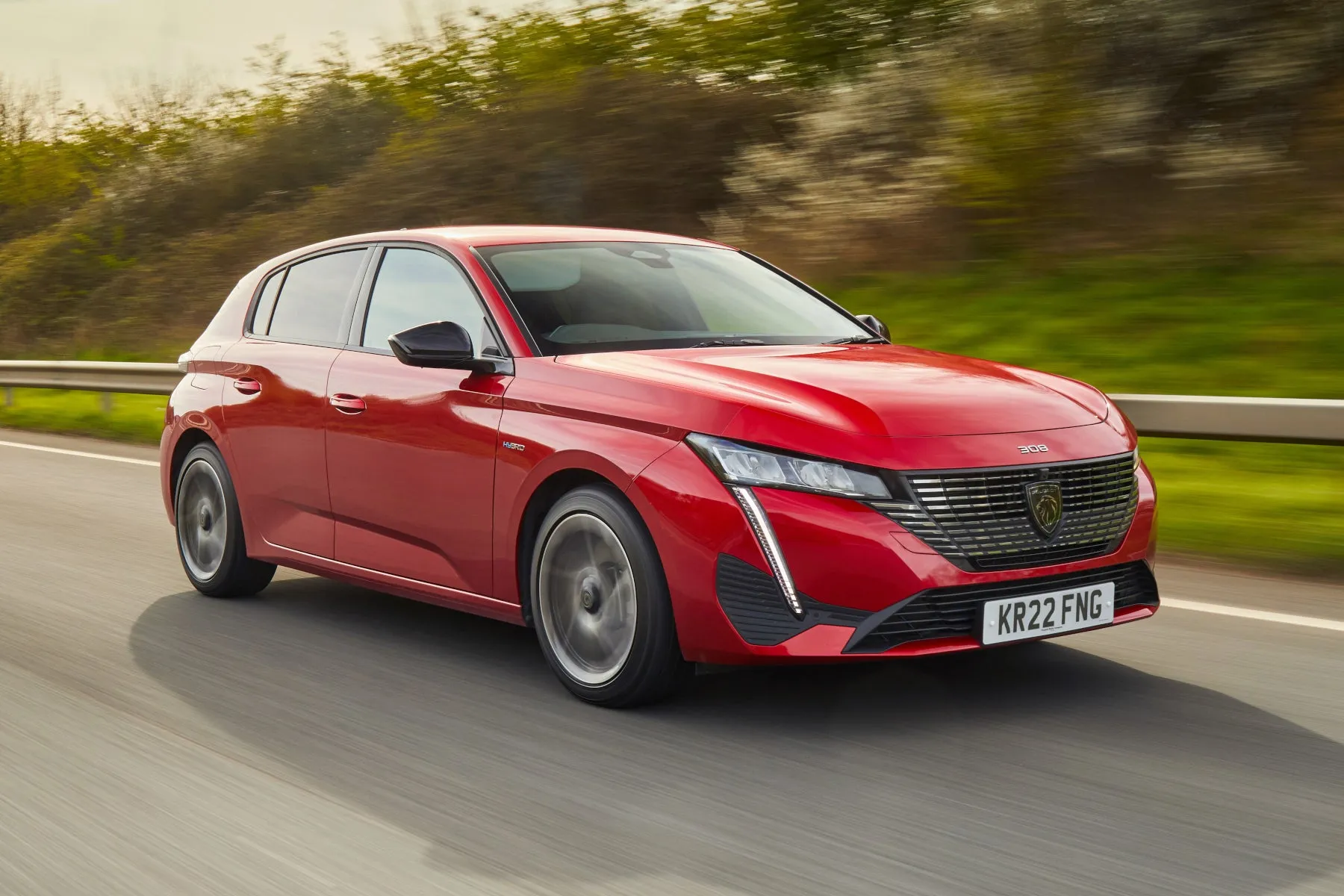
We'll start with the Puretech 130 petrol, which promises up to 51.9mpg on the WLTP combined cycle. Expect a figure somewhere in the mid-forties in mixed driving.
The BlueHDI 130 diesel betters that with as much as 59.6mpg combined depending on driving style. It's the best bet for those who do lots of motorway miles. The mild hybrid 308 HYBRID 136 e-DSC gives an average figure of 62.6mpg to better the diesel by a small margin, and that figure is matched by the more powerful 145PS iteration that came later.
The early plug-in hybrid models both claimed identical consumption figures of 242.7mpg according to official calculations. That figure was shared by the later version of the 180PS PHEV, which is rated for up to 47 miles of electric range, while the 195PS version gets a slightly bigger battery for a range of up to 60 miles, giving an overall fuel consumption figure of 428.0mpg.
Either way, those figures are simply for comparison to other PHEVs, as you'll only get near that figure on short journeys where you can use electric power the majority of the time. Do longer journeys with a depleted battery, and they'll almost certainly be less efficient than the pure petrols and diesels.
If it's a lot of emissions-free miles you want to do, the E-308 pure EV model is the one to have. It has a claimed driving range on a full charge of up to 257 miles. However, you are very unlikely to see this as it would mean running the car from 100 per cent charge to zero, and that assumes you are driving in the most efficient fashion possible.
Peugeot 308 reliability and warranty
Peugeot didn't do awfully well in the latest Honest John Satisfaction Index, coming 29th out of 33 car makers in the reliability standings, and 28th for overall satisfaction. Perhaps more alarmingly the Peugeot 308 came out as the sixth least reliable model in the entire study, although that did relate to the previous 2014-2021 model. A glitchy touchscreen was the main sources of woes, while costly repairs were cited by owners as another big frustration.
Peugeot's warranty is pretty rubbish, too. You get two years of unlimited-mileage manufacturer-supplied cover, followed by a third year of retailer-supplied cover limited to 60,000 miles.
Peugeot 308 insurance groups and costs
The old 130PS version of the 1.2-litre petrol model of the Peugeot 308 is the cheapest to insure: no surprise there. It sits in group 19, while the petrol and diesel engines in the range don't stretch any further than group 21 out of 50.
The older plug-in hybrids had ratings of between 26 and 30, but the latest ones range between 26 and 28 depending on trim level.
VED car tax: What is the annual road tax on a Peugeot 308?
All cars built since April 2017 are now liable for the same amount of road tax regardless of what fuel powers them, and this flat rate currently stands at £195 per year. However, cars that cost more than £40,000 when brand new are also subject to an additional 'luxury car surcharge', which adds another £425 to your annual bill for a five-year period between years two and six of the car's life.
All early 308s sat under this price threshold, but inflation means that prices inevitably rise over time, and a couple of the higher-end versions of the car now bust that threshold, and even some of those that don't can easily be taken over with the addition of a few optional extras, whether that be by you or a previous owner. Whatever the case, when buying used, it's always a good idea to Google the reg of the car you're considering so you know precisely what you're looking at.
Peugeot 308 price
"The Peugeot 308 isn't the cheapest family hatchback around, but nor is it the most expensive. And, given it has some desirability and upmarket appeal, we reckon it's decent value."
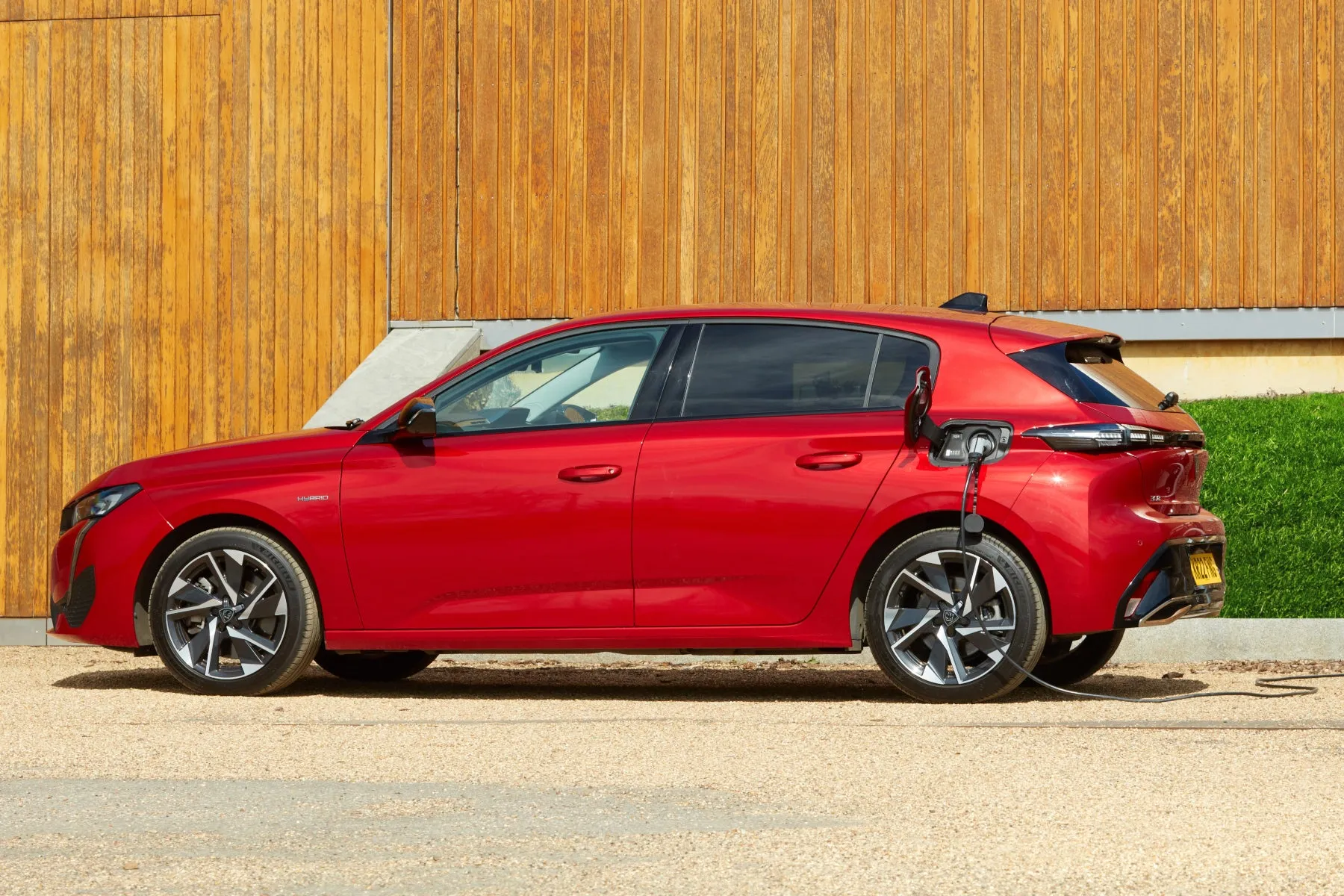
Prices start at around £33,000 for the entry-level mild hybrid petrol model, while the diesel only costs a few hundred quid more. You'll need around £38,000 for either of the plug-in hybrids in Allure trim, while the upgrade to GT trim will cost you around three grand across the board.
As ever, significant savings can be made by buying a used version of this third-generation 308. Browsing our classifieds reveals the cheapest examples starting at around £15,000: this will be for a 1.2 petrol car in Active Premium or Allure trim, from 2022 or 2023, with between 30,000- and 40,000 miles on the clock. Diesels can be had for a similar sum, too. The cheapest PHEV we've seen came in at around £19,000, with just two years and 11,000 miles beneath its wheels.
Trim levels and standard equipment
At its launch, the base-level 308 was the Active Premium with power-folding mirrors, 16-inch alloys, 'EcoLED' headlights and LED rear lights, automatic lights and wipers, rear parking sensors, the full infotainment suite and automatic emergency braking.
Allure trim upgrades the wheel size to 17-inches, and introduces various other styling detail upgrades. You also get an AQS 3 air quality system, front parking sensors, tinted windows, a reversing camera, a drive mode selector, part faux leather trim, ambient lighting, high beam assist, upgraded LED running lights and sat-nav with live traffic updates. PHEV models get remote pre-heating and cooling, too.
Allure Premium trim adds the Drive Assist Pack with adaptive cruise control, rear-cross traffic alert and blind spot detection, while keyless entry and start, wireless phone charging and wireless Apple CarPlay and Android Auto also features.
Step up to GT trim for an enhanced air quality system, 3D digital instruments, a heated steering wheel, the Driver Sport Pack, a green stitched leather steering wheel, Alcantara and faux-leather trim, black headlining, aluminium door sills, exterior styling upgrades, 18-inch alloys, full Matrix LED headlights and upgraded 'Claw Effect' LED rear lights.
Flagship GT Premium trim gets Lane Positioning Assist, two-tone 18-inch alloys, a 360-degree parking camera and self-parking aid, an electric tailgate, upgraded front seats with electric adjustment on the driver's side and heating and massaging for both front seats, electric lumbar adjustment and a Focal Premium sound system.
Peugeot later refined the 308 range to the simpler Active, Allure, and GT trims, which come with the same kit count as detailed above. The company has since refined the range further to include just Allure and GT trims: the GT gets as much as ever, but Allure cars actually get a little less in the way of standard kit than before.
Ask the heycar experts: common questions
Is the Peugeot 308 a good car?
Do Peugeot 308s hold their value?
Is the Peugeot 308 reliable?
Get our latest advice, news and offers
Keep me updated by email with the latest advice, news and offers from heycar.
By submitting you agree to our privacy policy





